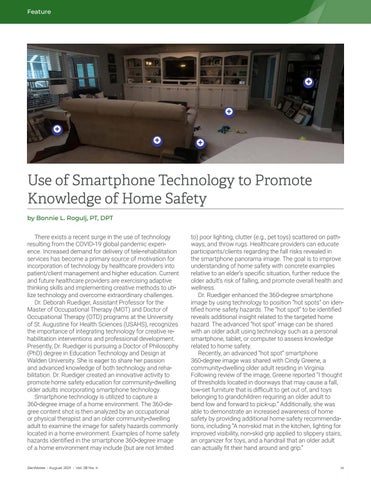Feature
Use of Smartphone Technology to Promote Knowledge of Home Safety by Bonnie L. Rogulj, PT, DPT There exists a recent surge in the use of technology resulting from the COVID-19 global pandemic experience. Increased demand for delivery of tele-rehabilitation services has become a primary source of motivation for incorporation of technology by healthcare providers into patient/client management and higher education. Current and future healthcare providers are exercising adaptive thinking skills and implementing creative methods to utilize technology and overcome extraordinary challenges. Dr. Deborah Ruediger, Assistant Professor for the Master of Occupational Therapy (MOT) and Doctor of Occupational Therapy (OTD) programs at the University of St. Augustine for Health Sciences (USAHS), recognizes the importance of integrating technology for creative rehabilitation interventions and professional development. Presently, Dr. Ruediger is pursuing a Doctor of Philosophy (PhD) degree in Education Technology and Design at Walden University. She is eager to share her passion and advanced knowledge of both technology and rehabilitation. Dr. Ruediger created an innovative activity to promote home safety education for community-dwelling older adults incorporating smartphone technology. Smartphone technology is utilized to capture a 360-degree image of a home environment. The 360-degree content shot is then analyzed by an occupational or physical therapist and an older community-dwelling adult to examine the image for safety hazards commonly located in a home environment. Examples of home safety hazards identified in the smartphone 360-degree image of a home environment may include (but are not limited GeriNotes • August 2021 • Vol. 28 No. 4
to) poor lighting, clutter (e.g., pet toys) scattered on pathways, and throw rugs. Healthcare providers can educate participants/clients regarding the fall risks revealed in the smartphone panorama image. The goal is to improve understanding of home safety with concrete examples relative to an elder’s specific situation, further reduce the older adult’s risk of falling, and promote overall health and wellness. Dr. Ruediger enhanced the 360-degree smartphone image by using technology to position “hot spots” on identified home safety hazards. The “hot spot” to be identified reveals additional insight related to the targeted home hazard. The advanced “hot spot” image can be shared with an older adult using technology such as a personal smartphone, tablet, or computer to assess knowledge related to home safety. Recently, an advanced “hot spot” smartphone 360-degree image was shared with Cindy Greene, a community-dwelling older adult residing in Virginia. Following review of the image, Greene reported “I thought of thresholds located in doorways that may cause a fall, low-set furniture that is difficult to get out of, and toys belonging to grandchildren requiring an older adult to bend low and forward to pick-up.” Additionally, she was able to demonstrate an increased awareness of home safety by providing additional home safety recommendations, including “A non-skid mat in the kitchen, lighting for improved visibility, non-skid grip applied to slippery stairs, an organizer for toys, and a handrail that an older adult can actually fit their hand around and grip.” 18










